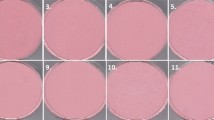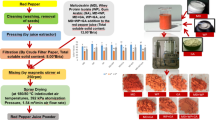Abstract
Encapsulated Asian pear juice powder was produced through spray drying using three maltodextrin levels (15, 20, and 25% w/v) and three inlet air temperatures (130, 150, and 170 °C). The impact of maltodextrin concentrations and inlet air temperatures on color, bioactive compounds, and morphological characteristics of encapsulated Asian pear juice powder were investigated. Maltodextrin concentrations and inlet air temperatures significantly influenced L* and b* values of encapsulated Asian pear juice powder. Increasing inlet air temperatures increased total phenolic content, whereas the vitamin C content decreased. Vitamin C content was strongly correlated with particle size, inlet air temperature, and maltodextrin concentration. ABTS+ radical-scavenging activity was highly correlated with total phenol content while DPPH radical-scavenging activity was highly correlated with vitamin C content. Encapsulated powders made with higher inlet air temperature and higher maltodextrin concentration had lowest median particle diameter with a smoother, more regular and rounded outer surface than those of encapsulated powders produced with lower inlet air temperature and lower maltodextrin concentration. Therefore, the results demonstrate that high-quality encapsulated Asian pear juice powder could be manufactured by adding 15% (w/v) maltodextrin and spray-drying at 170 °C.



Similar content being viewed by others
References
Abac ZT, Sevindikb E, Ayvaz M (2016) Comparative study of bioactive components in pear genotypes from Ardahan/Turkey. Biotechnol Biotech Equip 30:36–43
Ahmed M, Akter MS, Eun JB (2010) Impact of α-amylase and maltodextrin on physicochemical, functional and antioxidant capacity of spray-dried purple sweet potato flour. J Sci Food and Agric 90:494–502
Bastos DS, Goncalves MP, Andrade CT, Lima-Araújo KG, Rocha-Leão MHM (2012) Microencapsulation of cashew apple (Anacardium occidentale, L.) juice using a new chitosan–commercial bovine whey protein isolate system in spray drying. Food Bioprod Process 90:683–692
Bermudez-Soto MJ, Tomas-Barberan FA (2005) Evaluation of commercial red fruit juice concentrates as ingredients for antioxidant functional juices. Eur Food Res Technol 219:133–141
Blois MS (1958) Antioxidant determination by the use of a stable free radical. Nature 26:1199–1744
Castro-Munoz R, Barragan-Huerta BE, Yanez-Fernandez J (2015) Use of gelatin-maltodextrin composite as an encapsulation support for clarified juice from purple cactus pear (Opuntia stricta). LWT Food Sci Technol 62:242–248
Chopda CA, Barrett DM (2001) Optimization of guava juice and powder production. J Food Process Preserv 25:411–430
Doner LW, Hickts KB (1981) High-performance liquid chromatographic separation of ascorbic acid, erythorbic acid, dehydroascorbic acid, dehydroerythorbic acid, diketogulonic acid, and diketoglunoconic acid. Anal Biochem 115:225–230
Eghdami A, Sadeghi F (2010) Determination of total phenolic and flavonoids contents in methanolic and aqueous extract of Achillea millefolium. J Org Chem 2:81–84
Fang Z, Bhandari B (2011) Effect of spray drying and storage on the stability of bayberry polyphenols. Food Chem 129:1139–1147
Fang Z, Bhandari B (2012) Comparing the efficiency of protein and maltodextrin on spray drying of bayberry juice. Food Res Int 48:478–483
Fazaeli M, Emam-Djomeh Z, Ashtari AK, Omid M (2012) Effect of spray drying conditions and feed composition on the physical properties of black mulberry juice powder. Food Bioprod Process 90:667–675
Ferrari CC, Germer SPM, Aguirre JM (2012) Effects of spray-drying conditions on the physicochemical properties of blackberry powder. Dry Technol 30:154–163
Galvis-sanchez A, Gil-lzquierdo A, Gil MI (2003) Comparative study of six pear cultivars in terms of their phenolic and vitamin C contents and antioxidant capacity. J Sci Food Agric 83:995–1003
Goula AM, Adamopoulos KG (2004) Spray drying of tomato pulp: effect of feed concentration. Dry Technol 22:2309–2330
Goula AM, Adamopoulos KG, Kazakis NA (2004) Influence of spray drying conditions on tomato powder properties. Dry Technol 22:1129–1151
Ho LP, Pham AH, VVM Le (2015) Effects of core/wall ratio and inlet temperature onthe retention of antioxidant compounds during the spray drying of sim (Rhodomyrtus tomentosa) juice. J Food Process Preserv 39:2088–2095
Horszwald A, Julien H, Andlauer W (2013) Characterisation of Aronia powders obtained by different drying processes. Food Chem 141:2858–2863
Kha TC, Nguyen MH, Roach PD (2010) Effects of spray drying conditions on the physicochemical and antioxidant properties of the Gac (Momordica cochinchinensis) fruit aril powder. J Food Eng 98:385–392
Kirca A, Ozkan M, Cemeroglu B (2007) Effects of temperature, solid content and pH on the stability of black carrot anthocyanins. Food Chem 101:212–218
Kuck LS, Noreña CP (2016) Microencapsulation of grape (Vitis labrusca var. Bordo) skin phenolic extract using gum Arabic, polydextrose, and partially hydrolyzed guar gum as encapsulating agents. Food Chem 1:569–576
Larrigaudière C, Lentheric I, Puy J, Pintó E (2004) Biochemical characterisation of core browning and brown heart disorders in pear by multivariate analysis. Postharvest Biol Technol 31:29–39
Mishra P, Mishra S, Mahanta CL (2014) Effect of maltodextrin concentration and inlet temperature during spray drying on physicochemical and antioxidant properties of amla (Emblica officinalis) juice powder. Food Bioprod Process 92:252–258
Muzaffar K, Dinkarrao BV, Kumar P (2016) Optimization of spray drying conditions for production of quality pomegranate juice powder. Cogent Food Agric 2:1127583
Patil V, Chauhan AK, Singh RP (2014) Optimization of the spray-drying process for developing guava powder using response surface methodology. Powder Technol 253:230–236
Polinati RM, Faller ALK, Fialho E (2010) The effect of freezing at −18°C and −70°C with and without ascorbic acid on the stability of antioxidant in extracts of apple and orange fruits. Int J Food Sci Technol 45:1814–1820
Quek SY, Chok NK, Swedlund P (2007) The physicochemical properties of spray-dried watermelon powder. Chem Eng Process 46:386–392
Re R, Pellegrini N, Proteggente A, Pannala A, Yang M, Rice-Evans C (1999) Antioxidant acitivity applying an improved ABTS radical cation decolorization assay. Free Radic Biol Med 26:1231–1237
Rehman M, Shekunov BY, York P, Lechuga-Ballesteros D, Miller DP, Tan T, Colthorpe P (2004) Optimisation of powders for pulmonary delivery using supercritical fluid technology. Eur J Pharm Sci 22:1–17
Rodríguez-Hernández GR, González-García R, Grajales-Lagunes A, Ruiz-Cabrera MA, Abud-Archila M (2005) Spray-drying of cactus pear juice (Opuntia streptacantha): effect on the physicochemical properties of powder and reconstituted product. Dry Technol 23:955–973
Salvador H, Guzman-maldonado A, Morales-montelongo L, Mondragon-jacobo C, Herrera-hemandez G, Guevara-lara F, Reynoso-camacho R (2010) Physicochemical, nutritional, and functional characterization of fruits xoconostle (Opuntia matudae) pears from central-Mexico region. J Food Sci 75:485–492
Santiago MCPA, Nogueira RI, Paim DRSF, Gouvea ACMS, Godoy RLO, Peixoto FM, Pacheco S, Freitas SP (2016) Effects of encapsulating agents on anthocyanin retention in pomegranate powder obtained by the spray drying process. LWT Food Sci Technol 73:551–556
Selvamuthukumaran M, Khanum F (2014) Optimization of spray drying process for developing sea buckthorn fruit juice powder using response surface methodology. J Food Sci Technol 51:3731–3739
Wang MF, Shao Y, Li JG, Zhu NQ, Ho CT (1998) Antioxidative phenolic compounds from sage (Salvia officinalis). J Agric Food Chem 46:4869–4873
Wariyah CH, Riyanto (2016) Antioxidative activity of microencapsulated aloe vera (Aloe vera var. chinensis) powder with various concentrations of added maltodextrin. Int Food Res J 23:537–542
Yim SH, Nam SH (2016) Physiochemical, nutritional and functional characterization of 10 different pear cultivars (Pyrus spp.). J Appl Bot Food Qual 89:73–81
Zhang UB, Choi HJ, Han HS, Park JH, Son JH, Bae JH, Seong TS, An BJ, Kim HG, Choi C (2003) Chemical structure of polyphenol isolated from Korean pear (Pyrus pyrifolia Nakai). Korean J Food Sci Technol 35:959–967
Author information
Authors and Affiliations
Corresponding author
Rights and permissions
About this article
Cite this article
Lee, CG., Ahmed, M., Jiang, GH. et al. Color, bioactive compounds and morphological characteristics of encapsulated Asian pear juice powder during spray drying. J Food Sci Technol 54, 2717–2727 (2017). https://doi.org/10.1007/s13197-017-2708-3
Revised:
Accepted:
Published:
Issue Date:
DOI: https://doi.org/10.1007/s13197-017-2708-3




